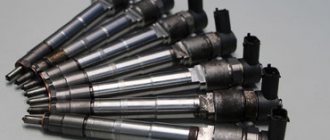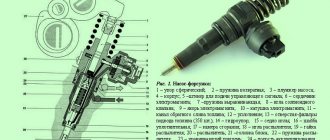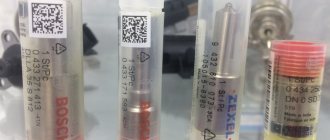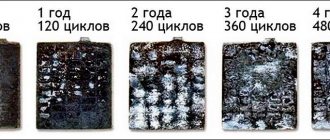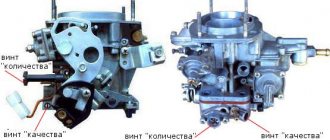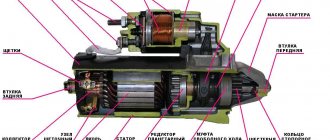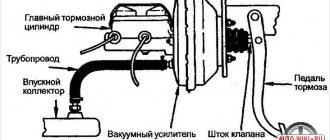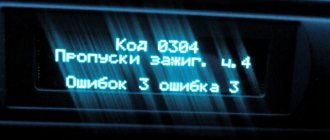Although modern diesel engines are becoming more and more complex, the Common Rail system from a technical point of view seems even simpler than previously used systems with a mechanical fuel injection pump. Ultimately, the Common Rail system completely drove competing solutions, such as unit injectors, out of the market.
Various concepts
There are several types of Common Rail systems used in passenger cars. Simplified, they can be divided into two types (electromagnetic and piezoelectric) and four manufacturers (Bosch, Continental, Delphi, Denso). Bosch, Delphi and Denso are well-known manufacturers of automotive electronics. Bosch created injection systems at the very beginning of the last century. Delphi purchased diesel fuel injection technology from Lucas. Japanese Denso gained experience by working together with Bosch and Magnetti Mareli. Continental acquired Siemens and VDO, becoming the main competitor of the German Bosch. The injectors of this company have been marked with the Continental logo for about a year; previously they bore the Siemens logo.
The most versatile is the market leader - Bosch, which produces both types of injectors: electromagnetic and piezoelectric. On a much smaller scale, both types of injectors are produced by Delphi and Denso. Continental (Siemens) is limited exclusively to piezoelectric technology.
Common Rail injector types
To optimize the operation of the system, only two types of nozzles are used:
electrohydraulic (injection is carried out through an electromagnetic valve mechanism);
piezoelectric (special piezo crystals are used for injection).
Today, injectors manufactured by Bosch, Siemens, Delpha and Denso have become widespread in the automotive industry. They are installed on diesel versions of BMW, Scania, Ford, Nissan, Honda, Hyundai, Suzuki, Mazda, Mitsubishi and others.
Differences between a diesel injector and a gasoline injector
The main difference between a diesel injector and a gasoline injector can be considered its performance. Thus, on gasoline injection engines, the operating pressure of the injector is usually 2–5 atmospheres. This is enough to develop the speed and traction of the car. And the standard operating pressure of injectors on the Common Rail usually reaches 250 atmospheres; the latest generation of SUVs have injectors with an operating pressure of up to 1000 atmospheres.
Accordingly, the higher the pressure in the system, the more fuel the engine can receive and the higher its declared power.
In addition, a diesel injector has a more complex structure, which is why it costs several times more than a gasoline injector.
Every sandpiper praises his swamp
In advertising brochures, each manufacturer praises its product as the best solution. As you may have guessed, in practice many of them often have a number of shortcomings. Bosch electromagnetic injectors have the simplest design. Repairing German injectors is not difficult. Delphi wanted to go further and developed a much more complex control system for its electromagnetic injectors. As a result, his product turned out to be the most sensitive to fuel quality and, unfortunately, not very durable. Among electromagnetic injectors, Denso is considered the most reliable, but there are difficulties with the availability of spare parts for repairs. Piezoelectric injectors designed by Bosch and Siemens (Continental), and also partly by Denso, are considered the most balanced. The injectors are similar to each other, both technically and in terms of reliability. Only Delphi stands out from this group, whose piezo injectors have always been considered less durable.
Whose injectors can be repaired?
From the point of view of repairability, the most preferable are turbodiesels with classic Common Rail injection from Bosch. Almost all specialized centers can handle the restoration of injectors of this type. But the final result depends on the diligence and honesty of the master. Delphi electromagnetic injectors can also be repaired, but require replacement of the tip and injector coding after repair. This increases the cost of repairs, but without coding the engine will run rough. Denso electromagnetic injectors are among the most durable, but repairs are only possible if spare parts are available. But this is not all good.
Delphi and Bosch piezo injectors are considered non-repairable. In the case of Siemens (Continental), injection tips have appeared that allow you to change the size, which allows you to restore the functionality of the injector. However, this only applies to some models with PSA 2.0 HDI 16V engines. Various modifications of this turbodiesel are used in Ford Mondeo IV, Focus, Galaxy, S-Max and Volvo S40, S60.
What to look for?
The advantages and disadvantages of injectors should be known at the stage of choosing a car. Given the risk of injector failure, two models with the same engine should be avoided like fire: Ford Mondeo III 2.0 TDCi and Jaguar X-Type 2.0 d. The injectors of the Mercedes E250 CDI W212 from the beginning of production also had congenital defects. Other cars with Delphi injectors do not cause any complaints. Some engines allow the use of injectors from different manufacturers. For example, the 1.6 HDi/TDCi engine had four different types of injection systems, and the cheapest to maintain was Bosch. The situation is similar with 2.0 HDi. Siemens (Continental) injectors can be rebuilt, but Bosch piezo injectors cannot.
Advantages of a direct fuel injection system
If a car is equipped with a common rail fuel system, then the operation of such a vehicle will be much cheaper compared to cars equipped with simple diesel units, due to significantly lower fuel consumption per 100 km of run. For people who care about the environment, purchasing a car equipped with a Common rail delphi diesel engine is a reasonable alternative between a car with a gasoline engine and an electric car.
What do you need to know about common rail injectors?
Bosch electromagnetic injectors
They are disassembled and relatively easy to repair. The cost of restoring one injector is about 100-150 dollars apiece. They can withstand 200,000 km. In Opel's 1.9 CDTi and Fiat's 1.9 JTD, the injectors can last up to 500,000 km. The price of a new nozzle is about $250-300 apiece.
Alfa Romeo 159 2.0 JTDM, Fiat Punto 1.3 JTD, Kia CEE'D 1.6 CRDi, Mercedes C 220 CDI W202, Opel Vectra C 1.9 CDTI, Renault Laguna II 1.9 DCI, Volvo V70 D5, BMW 320d E46.
Delphi electromagnetic injectors
Compared to Bosch, Delphi injectors are much more sensitive to fuel quality. They are a little more expensive to repair - about $150-$200 each - due to the need for coding with a new tip. Average service life is 150,000 km. The cost of a new injector is about $250.
Dacia Logan 1.5 DCI, Ford Focus 1.8 TDCi, Renault Megane II 1.5 DCI Nissan Almera 1.5 DCI, Hyundai Santa Fe 2.2 CRDi, Kia Carnival 2.9 CRDi, Ford Mondeo 2.0 TDCi III.
Denso electromagnetic injectors
Denso electromagnetic injectors are considered the highest quality. Until recently, there was a shortage of spare parts, but now most of them can be restored. The cost of repairs is about $150-250 per unit. The price of a new injector is about $450.
Mazda 6 2.0 CD, Nissan Pathfinder 2.5 DCI, Opel Corsa 1.7 CDTI, Mitsubishi Pajero 3.2 DI-D II, Toyota Avensis 2.0 D-4D.
Why are the injectors knocking?
In most cases, this is due to the fuel entering the cylinder. We are talking about excess fuel; its entry into the cylinder leads to the appearance of uncharacteristic sounds. The problem can be solved by adjusting the fuel equipment.
Another common reason is wear of the nozzles. The problem can be solved by replacing the nozzle. Before this, you can try to adjust the injection pressure, but the effect will be temporary, as will flushing the needle and nozzle cavity.
Return to list
Common Rail injection system malfunctions
As a rule, the Common Rail injection system is able to last more than 200,000 km without any problems. But everything depends not only on the design, but also on the operating conditions. Delphi injectors are the least reliable and most sensitive to fuel quality. The first problems sometimes appear already at 140,000 km. The most durable products are the Denso products. Piezoelectric injectors from Bosch and Continental (Siemens) typically withstand more than 200,000 km. Bosch electromagnetic injectors last the same amount of time.
Characteristic symptoms of common rail injection system malfunctions
— uneven engine operation;
— increased fuel consumption;
However, common rail system malfunctions are not always the result of damaged injectors. The defect could affect the high-pressure pump, fuel pressure regulator and other sensors. In any case, the operating parameters of the injection system give an almost exact answer to the question about the condition of the injectors.
Detonation knocks
Early fuel injection on diesel engines causes detonation combustion of the working fuel-air mixture. Detonation leads to knocking, rough and harsh operation of the diesel engine. The concept of detonation refers to a disruption of the normal combustion process of diesel fuel in the combustion chamber.
Detonation does not mean combustion of fuel, but an explosion. The entire portion of the fuel mixture burns instantly. The pressure on the piston, which has not yet reached top dead center, increases sharply. Also, as a result of detonation, a shock wave is formed, which is reflected from the piston, destroying the piston itself and the rings.
Explosions in the cylinders cause the characteristic knocking sounds of a diesel engine. The main signs of detonation in a diesel engine are metallic (relatively loud) knocking in the cylinders, the engine is shaking, the cylinder head is overheating, and power is reduced. Another reason for diesel detonation may be a malfunction of diesel injectors or fuel injection pump (high pressure fuel pump). Excessive leanness of the mixture leads to similar explosions in the combustion chamber.
What not to do in the garage
You can “examine” the system using a special diagnostic computer using pressure parameters and the so-called “injector correction”. Another simple way is to determine the amount of overflow. It is also possible to remove the injectors for inspection or testing on a bench. Unfortunately, in some cases it is impossible to remove the nozzle - it gets stuck.
What determines the performance of products?
Injectors are the most important component of the fuel system. With their help, fuel is dosed and transported to the engine. Among the standard set of functions are:
- Preparation of fuel and creation of optimal conditions for its transportation;
- Connection of the combustion chamber to the fuel injection system for full operation of the fuel system;
- Maintaining normal performance of the engine and fuel pump.
The correct operation of the injectors has a great influence on the starting of the car engine and the dynamics of its consumption. Also, the amount of fuel consumed and hazardous exhaust into the atmosphere depends on the operation of the injectors.
In total, two main types of products can be distinguished: electromechanical and mechanical nozzles. A distinctive feature of the first type is its complex design; control is carried out by a special valve, for the regulation of which an electronic system is responsible.
Mechanical models are a simpler option; their main advantage is their reliable design. The operation of this category of products is based on the fact that achieving the required pressure leads to the opening of the valve. At this point in time, such injectors are gradually losing their relevance, which is due to modern requirements that highlight the protection of the environment from harmful exhausts.
How to repair
Electromagnetic injectors
Technical capabilities allow us to restore all electromagnetic injectors (Bosch, Delphi, Denso). Limitations may be imposed by the availability of spare parts: valves, tips, coils, housings, etc.). In the case of Bosch there are no problems. It's a little worse with the Delphi components. But for Denso, original components simply do not exist. There are only a small proportion of unofficial substitutes. The cost of restoration repairs depends on the number of elements being replaced and the manufacturer of the injectors. For Bosch, the estimated amount will be from 50 to 150 dollars per piece, and for Delphi and Denso - up to 200-250 dollars.
Piezoelectric injectors
A complete restoration of piezoelectric injectors from Bosch, Delphi and Denso is not possible. All that is permissible is to remove the nozzle tip, wash it in an ultrasonic device and check the operation of the nozzle on a stand.
The situation is slightly better with some Continental (Siemens) injectors. Spare parts are available for individual injectors. The cost of restoration is about $150.
Injector repair
Disassembly and repair of injectors should only be carried out by specialized service specialists. Disassembling the nozzle itself requires a special tool. In addition, before and after disassembly, it is necessary to check the operation of the nozzle on a special stand.
— checking the injector on the stand;
— dismantling and washing of elements;
— troubleshooting and replacement of necessary parts;
— adjustment and assembly of the nozzle;
— measurement of parameters after assembly;
— assignment of an individual code that takes into account the characteristics of a specific instance (for some injectors).
Only after the regeneration process and elimination of associated faults (for example, sediment in the tank or chips from the pump in the system), the nozzles can be installed back in their place. At the same time, the fuel filter and copper washers under the injectors must be replaced.
At first glance, it may seem that the nozzle is a super mega difficult device, but this is not entirely true - the most high-tech thing about it is the gaps between the parts, the quality of its work depends on them, the spray into the cylinders, for which the nozzle at the bottom of the nozzle is responsible, and also hydro density - for which the multiplier with a seat and a ball is responsible, these are the main wearing parts in the nozzle, and the worse the quality and lubricating properties of the fuel - the faster wear occurs and the performance deteriorates... You can read about all the problems on the Internet, the main ones are the injector. the injector is jammed into the cylinder; loss of hydrodensity affects the entire system as a whole.
Let's start with the fact that I probably bought a used injector that was not working for experiments when I had an error in the fuel system and I had a fault with the injectors - more precisely, with the drain into the return line, I had it 40-45 ml, according to the tolerance 17-72 ml is permissible, in Ideally, generally only drops... My nozzles generate dust well - you can see this click here But still, I bought it and wanted to take it apart - but I didn’t have time because the problem was solved - the fuel pump was dying and did not give pressure from this and the error - of course, if the forces If they didn’t drain so much, the pump would still work. At disassembly there was only BMW 13 53 7 794 334 (Bosch 0 445 110 216) for Euro 4, I also have BMW 13 53 7 789 670 (Bosch 0 445 110 131
) They are designed almost identically, there are probably slight differences... So the disassembly process... I read it on the Internet, but there are many nuances... We unscrew the sprayer, I didn’t get the needle itself - it’s probably coked. Then the upper part, until I got to the nut with an internal hexagon, it I would unscrew it, but there is a pin there - and you need a special head or a drilled hexagon, so the process is suspended, while you look at what the atomizer and electromagnet consists of, a little cat, already grown))) then don’t switch continuum as soon as I find or make a tool - I’ll disassemble the force further and let's see the giblets...
How to repair Comon Rail diesel engine injectors
In some cases, when there is a need to repair an injector, it is best not to waste your time on disassembling and cleaning, but it is better to immediately buy a new product. However, how to determine the feasibility of repairs? It all depends on the specific brand of injector.
Bosch Common Rail
The manufacturers of this injector made sure that it is easy to repair and restore. If your diesel engine is equipped with Bosch injectors, then it is more profitable to make minimal repairs than to invest in the purchase of new injectors.
The weakest parts of Bosch are the multiplier and the atomizer. That is, most often it is these parts that have to be changed.
A multiplier is a valve that consists of a seat and a stem. Usually, during operation, the seat into which the rod rests is severely broken. The saddle can be purchased separately and replaced with a new one; moreover, you just need to bend the clamps and remove the old element. But if the rod is worn out, then it will be impossible to replace it - it is better to immediately buy a new multiplier.
The nozzle is less likely to be subject to wear and tear: Bosch provides a factory warranty for this nozzle element. That is, the sprayer is unlikely to break sooner than after 100 thousand kilometers. However, due to the use of low-quality fuel, breakdowns are possible after 20–30 thousand kilometers. According to the existing technology for repairing atomizers, it is often enough to clean them with ultrasound. If the car owner does not have the opportunity to carry out ultrasonic irradiation of the nozzle, then you can get by with cleaning the sprayer with a regular can of compressed air.
The product for fuel injection into a diesel engine has an increased service life and can be easily repaired in case of breakdowns.
Delphi Common Rail
In injectors of this type, only two elements can be repaired - the valve mechanism and the atomizer itself. Just like Bosch injectors, they are easy to disassemble and clean.
The valve mechanism on Delphi is designed a little differently: it has a turntable that lowers and rises, thereby cutting off the fuel supply. The coating on the turntable quickly wears out, and its seat also breaks. It's easier to replace the valve itself than to insert a new turntable into it.
It is also recommended to clean the sprayer with ultrasound. If cleaning does not produce results, then it is easier to replace the sprayer with a new one. You can remove the part from the nozzle with one movement of your hand: the new nozzle is screwed in exactly the same way.
The unique design of this nozzle lies in the use of a spinner
Denso Common Rail
The Denso injector has a service life of up to 150 thousand kilometers. With such a long service life, it also costs much less than its European counterparts. However, problems may arise in terms of injector repair. Thus, Denso does not sell spare parts for its injectors. That is, if the product fails, the only option is to buy a new one.
In some cases, car owners assemble one from several used injectors, but this requires a certain patience and skill, since Denso is not initially designed for repairs.
The only way to improve the throughput and restore the operation of the nozzle is to carry out ultrasonic cleaning. This will temporarily restore Denso's performance properties.
The productivity and high quality of this nozzle has one big drawback - it cannot be repaired or restored.
Piezo Bosch, Piezo Siemens
Manufacturers Bosch and Siemens also produce a new generation of injectors, which are called piezoelectric. Instead of an electromagnetic valve, a piezo crystal is installed in them. Such an injector is very expensive (about 16 to 40 thousand rubles per product), but it provides precise metered fuel injection into the cylinder head.
The Piezo injector can fail for two reasons: a breakdown of the accumulator or a stuck valve mechanism. Spare parts for repairs will cost almost the same as the injector itself, and they are not yet available for free sale, meaning you will have to wait for the order to be delivered.
Repairing piezoelectric injectors will cost approximately the same amount as purchasing new ones, so it is more advisable to immediately order new products.
The latest generation injection device has a high service life and high cost
How to disassemble an injector (general instructions)
In order to begin repairs, you need to know how to properly disassemble the Common Rail injector body. Before work, you will need to prepare a screwdriver with a narrow flat blade - no other tools are required.
The disassembly procedure is as follows:
- Wipe the injector body to remove fuel with a clean, lint-free cloth.
- Disconnect the nozzle clamps (usually they are easily bent with your finger, but if bending is difficult, you can use a screwdriver blade).
- After this, remove the rubber ring from the tip.
- Next, it is recommended to unscrew the valve from the reverse side.
- The stem or needle comes out of the body easily after disconnecting the valve.
At this point, disassembling the injector can be considered complete.
Video: disassembling and repairing injectors with your own hands
Causes and signs of failure
First, it’s worth describing the design of the part itself using the example of a mechanical product with one compression spring. There is a channel on the side that is responsible for the continuous supply of fuel. Inside the chamber there is a barrier with a needle and a spring. As soon as the pressure increases, the barrier lowers and clears the way for diesel fuel to the sprayer.
This element of the internal combustion engine has a service life of 200 thousand kilometers, however, due to some negative factors, failure may occur earlier. There are three main reasons why the declared resource decreases:
- Use of low quality fuel. A common problem with all diesel engines is that due to impurities, the injector nozzle becomes clogged, the dosage is disrupted, and the fuel supply mode begins to work incorrectly.
- Manufacturing defects. If the part was purchased from a third-party unlicensed seller, there is a high chance that it will not withstand harsh operating conditions and will break.
- Mechanical damage. Occur due to improper operation of neighboring elements of the power unit.
Classic faults are cracks in the body, poor needle movement, changes in the amount of diesel supplied and the spray angle. It is also worth noting the symptoms that will indicate that you will have to repair diesel injectors yourself, or contact a specialist:
- Unstable operation of the engine at idle, the internal combustion engine stalls;
- jolts and jerks when driving;
- excessive exhaust;
- black or gray exhaust;
- failure of some cylinders;
- serious loss of traction.
Let's summarize the possible reasons
As you can see, in a diesel engine, the valves of the gas distribution mechanism or the pulleys on the crankshaft can knock. If a diesel engine knocks after a repair that involved changing the cylinder head gasket, then a sound similar to valve knocking may appear. The fact is that after tightening the head, the hole for the piston in the gasket may become smaller in diameter. The knocking occurs when the piston reaches TDC and touches the protruding part of the gasket with its head. The result may be that the cylinder head gasket of the diesel engine is blown.
On diesel engines, the knocking of the fuel injection pump is clearly audible. For diesel units, these knocks are noticeable in idle mode; the knock of the injection pump plunger pairs is characteristic. Pump diagnostics must be carried out by specialists who check the device on a special stand.
Another reason for knocking from a diesel engine may be weak tension on the timing belt or timing chain. The malfunction more often appears with increasing speed, when vibrations occur. The belt drive may contact the guard, causing a loud noise. Chain vibrations lead to increased noise during engine operation.
A knock may occur when the piston reaches the valves as a result of disrupted valve timing. The piston can also cause characteristic metallic knocks as a result of touching the cylinder head. This can happen after installing a gasket of inappropriate thickness, which is further pressed after the covering.
Why a cold engine may knock: various malfunctions. Analysis of the nature of the knock in the power unit: ringing, metallic, muffled, etc.
What does "engine breath" mean? Problems with the cylinder-piston group and timing belt, increased oil consumption. Malfunctions in the operation of the crankcase ventilation system of the internal combustion engine.
For what reasons does piston pin knocking occur during vehicle acceleration and operation under load: fuel quality, ignition, mixture composition, and others.
What should be understood by the definition of “knocked engine”. Why does the engine start knocking? In what cases does a knocking sound in the engine indicate a breakdown of the internal combustion engine.
What can knock, whistle, rustle and make other extraneous sounds under the hood after starting the engine. Diagnostics and determination of faults.
The most common causes of engine knocking are: piston knock, connecting rod knock, crankshaft knock. What to do if the engine suddenly starts knocking while driving.
How to repair diesel injectors
In some cases, it is possible to repair injectors yourself, but mechanisms from the Bosch and Delphi brands, as well as parts with Common Rail elements, will have to be repaired in specialized workshops.
Restoring such components will require specialized and expensive equipment and computer diagnostics; such equipment cannot be found in a garage association. As for mechanical injectors, they can be repaired with your own hands. It should be taken into account that the problem may be a loose fit of the needle to the nozzle seat (due to wear on the pressure pin). It is also worth taking into account the wear of the hole. These defects prevent a normal fit from being achieved, and therefore the part must be restored. First, let's outline the main points:
- To repair, you will have to remove the part. After inspection, you need to replace the nozzle, spacer and pressure pin. It is also recommended at this stage to unroll and install a new compression spring.
- Sealing and tight fit are achieved through high-quality processed surfaces, and therefore directly depend on the manufacturer (do not buy parts from unlicensed outlets).
- The hole in the guide channel where the spray needle goes has a gap and does not have seals. Excess fuel may get into the spring location.
- Excess diesel fuel is returned to the tank through a special return channel, and therefore stable pressure must be maintained in the nozzle.
Self-diagnosis
In the absence of expensive equipment in a garage, you can carry out some diagnostic measures yourself. If the engine does not start or, after starting, it operates extremely unstably, then the first thing that can be tested for serviceability is the glow plugs.
It is very easy to check glow plugs if you pass a voltage of twelve volts through them, and at the output connect an incandescent lamp of the same voltage with a power of 20 - 60 V. If the lamp glows brightly, then the spark plug is working; if the glow is dim or absent, you will need to replace the faulty part.
If, when you try to start a diesel engine, the working mixture does not ignite, then you should check the fuel system for the presence of fuel in it. The pressure at which the common rail delphi power system can ensure stable startup of the unit must be at least 150 atmospheres. The fuel system is checked in the following sequence:
- It is necessary to carefully inspect the fuel rail and all fuel pipes. If a fuel leak is detected from the system, it is necessary to immediately restore the tightness of the fuel line section;
- You should loosen the fitting leading to one of the injectors a few turns, crank the engine with the starter a few turns and check the operation of the high-pressure pump by looking at the fuel flowing out of this place. If there is no fuel in the power system, or its pressure differs less than the minimum required, then you will need to check the fuel injection pump, as well as the boost pump, which pumps fuel from the car’s tank.
The low pressure pump is checked using a return pressure gauge. The measuring device should show at least minus 1.5 atmospheres. Only in this case will the intake valve open and fuel will begin to flow into the system in the required volume. Diesel high pressure fuel pumps are best checked by removing this part from the engine. Garage craftsmen engaged in independent repairs construct homemade stands on which the pump is securely fixed and started using electric traction. A fuel hose containing diesel fuel is connected to the pump, and a pressure gauge is installed at the outlet, which will allow you to measure the pressure in the fuel system. The measuring device must be designed for high pressure, otherwise it will not be possible to correctly diagnose a pump failure. A working pump can pump fuel up to 2000 atmospheres, so all couplings should be securely fastened before turning on the system. This diagram will allow you to determine the serviceability of the high pressure pump. If the part turns out to be faulty, it should be replaced or the pump repaired at a service station.
There is no need to be afraid to use the latest technology in your daily life. In the near future, every diesel engine will be equipped with a Common rail delphi system, so when purchasing a car with this type of diesel engine, you don’t have to worry that the power unit will quickly become outdated, and it will be impossible to find original spare parts for it. If you constantly monitor the quality of the fuel poured into the fuel tank, then the number of kilometers traveled before the first major overhaul of an engine equipped with the Common rail delphi system will be in the hundreds of thousands, while each kilometer traveled will save money on the purchase of fuel.
Preparation for work and dismantling
To repair diesel injectors with your own hands, you need to prepare the following set of tools:
- straight and Phillips screwdrivers;
- a set of spanners and open-end wrenches;
- maximeter or multimeter;
- dry clean rags;
- engine flushing fluid.
Before disassembling, it is recommended to thoroughly rinse the engine compartment, paying special attention to the cylinder head. This will help keep foreign particles and debris out. Also, during the disassembly process, it would be a good idea to put a number on each part - this will be useful during reassembly.
Cover the injector fittings with plastic caps to avoid contamination. During dismantling itself, it is recommended to use spanners and tools with a long handle, and if you have enough practice, then open-end wrenches, but in this case there is a high risk of breaking the thread due to inexperience. After the nozzle is removed, it must be dried and wiped with a rag.
Injector diagnostics
You can check the unit for functionality even before dismantling it. This is done like this: start the engine at idle and remove the injectors one by one. If, after removing one of them, the operation of the engine has changed, then the part is in order and can be returned to its place. Thus, by the method of elimination it will be possible to detect a defective element.
For diagnostics you need to use a maximeter or multimeter. We remove the battery terminals, disconnect the injector wiring, and measure the performance of each part. For high-impedance products, the values should be in the range of 11-17 ohms, for low impedance products - less than 5 ohms. Let us note the characteristics that indicate the performance of the node:
- Injection should be carried out only at specific pressure levels; deviations in one direction or another are unacceptable.
- The injector should not overflow (fuel leakage before injection starts).
- After injection, a stable pressure must be maintained in each unit - this is required for the fuel to be discharged back into the tank.
- The optimal shape of the torch is an even cone without deviations.
- Optimal spraying is in the form of a “fog”. Do not allow fuel to drip or flow.
What is the Common Rail system
Common Rail is a type of fuel supply system. Most often it is called a battery fuel system, since a large volume fuel line (battery) is used as the main element.
Important! The system is used only on diesel engines.
These two main elements of the fuel supply system allow you to achieve maximum productivity in diesel engine operation.
System Features
The functionality of this system is based on the transfer of fuel to the injectors from a common battery, which is also called a fuel rail. As a matter of fact, “Common Rail” is translated from English as “common ramp”. Moreover, all elements of the injection system were developed by Bosch engineers, who are famous for their meticulous approach to the development of the smallest details.
Using the system allows:
minimize fuel consumption;
reduce the noise level of the motor;
reduce toxic emissions.
At the same time, the most important advantage of Common Rail is the large range of adjustment of fuel pressure and the instant of injection. Such characteristics are made possible by separating the operations of pressurizing the fuel system and injection.
Structurally, the system itself consists of several elements:
electronic control unit;
fuel rail as the basis of the system.
That is, unlike the traditional system for supplying fuel to the engine cylinders, the above system uses a high-pressure fuel pump with one channel. The injection pump ensures an uninterrupted supply of diesel fuel, thereby optimizing the operation of the engine unit.
Most of the latest generation diesel cars are equipped with a Common Rail system.
Advantages of Common Rail
Regardless of the brand of diesel car, using the system provides many advantages:
A stable high pressure is always maintained in the system, and its performance is not affected by the crankshaft rotation speed; thanks to this, the engine operates stably both at idle and at low speeds;
the electronic control unit doses the volumes of fuel that enter the engine as accurately as possible; This operating principle allows us to achieve complete combustion of each portion of fuel;
Structurally, the Common Rail system is considered to be as simple as possible, and it is also easy to repair, since all the necessary spare parts are freely available at reasonable prices.
I don’t know how the Japanese behave with Comon Rail, but Mercedes with this system drive normally and don’t cause any trouble even on our diesel fuel. I have experience in operating a Mercedes ATEG 8 t truck, mileage in Russia is about 300 thousand km. There were no problems with fuel.
Andrey 098
https://forums.drom.ru/mitsubishi/t1151054107.html
Disadvantages in operation
However, the Common Rail also has its disadvantages:
to equip diesel units with fuel, it is necessary to use injectors with a very complex structure; in addition, the injectors will require relatively frequent replacement;
if at least one element of this fuel system depressurizes, then the fuel supply to the cylinder head is completely stopped;
the system is very demanding on the quality of diesel fuel; If you refuel your car at dubious gas stations, the system will very quickly fail.
Yes, they don’t have any special problems. You just need to change the filter regularly, and don’t pour in just anything. Sometimes there are problems with starting and gaining speed due to clogging of the valves on the rack and fuel injection pump, but this is easy to clean and wash with your own hands. Injectors die much less often. This has already changed, but 40–60 is too early.
Kadiloff
https://forum.auto.ru/diesel/107153/#post-107161
Disassembling and cleaning the nozzle
Once the defective part has been identified, it must be disassembled for repair. This is done quite simply, after unscrewing the nut, we fasten the element in a vice (without strong clamping, so as not to deform the body) and knock out the nozzle with a light tap. Next, all internal parts are removed - the transition element, the adjusting throttle, the atomizer block and the magnetoelectric contact.
After disassembly, it is necessary to thoroughly clean each element. For these purposes, it is best to use a specialized flushing liquid. If you don’t have it at hand, use clean diesel fuel or acetone. It is necessary to completely remove carbon deposits and any contaminants. At the final stage, the body itself, the nut and the sprayer are rinsed in clean diesel fuel. Drying will also be required - for these purposes it is optimal to use compressed air from a compressor or just a dry rag.
After carrying out the work, you need to measure the injector with a multimeter; if the values are within the normal range, you can assemble it and put it back. It is likely that the sprayer has failed, in which case it needs to be replaced. By the way, the factory grease must be completely removed from the new element, otherwise it will not be possible to achieve normal operation.
The last stage is the reassembly of the part and its installation. It is not recommended to over-tighten the nuts immediately, as re-disassembly may be required after installation and inspection. The assembled injector is checked for compliance with all characteristics - correct “return” of fuel, correct atomization, hermetically sealed closure, and so on. If no problems are found, fully tighten the nut and install the injector on the engine, having previously carried out calibration.
Repair
Diesel injectors are repaired when flushing is unsuccessful. The entire repair essentially comes down to replacing the coked nozzle. If the problem persists, the return filter of the part is also replaced. To work we will need the following tools:
- repair kit for Common Rail (it consists of a new atomizer and return filter);
- set of open-end wrenches;
- special puller for these parts.
Repair sequence
- The puller is installed on the nozzle being removed.
To remove Common Rail injectors, it is best to use a proprietary puller - A rod is inserted into the puller, and a nut with a left-hand thread is screwed onto the rod (these rods and nuts are supplied complete with branded pullers).
A rod and nut with a left-hand thread are installed on the Common Rail injector - Use a 36mm open-end wrench to loosen the nut. Along with it, the element being repaired itself is weakened.
- Now the part is manually unscrewed from the socket.
The pre-loosened common rail injector is removed manually - An open-end wrench size 17 is put on it from the filter side, a wrench size 13 is put on the nozzle cap. After that, the wrench size 17 is held, and the sprayer cap is loosened with another wrench.
- Now the nozzle cap, loosened with keys, is unscrewed manually.
The Common Rail injector nozzle cover, previously loosened with keys, is unscrewed manually - The old sprayer is carefully removed from the lid and replaced with a new one.
The old dirty atomizer is removed from the Common Rail injector - The check valve is removed from the second part.
The common rail injector check valve can be removed after removing the injector - The return spring is removed from the check valve.
The common rail injector return spring is removed from the check valve. - The check valve is replaced with a new one.
The removed check valve of the Common Rail injector is replaced with a new one from the repair kit. - After this, reassembly is performed.
This is interesting: How to replace the heater radiator on a Chevrolet Niva with and without air conditioning
Video: repairing a Bosch common rail diesel injector
Adjustment after self-repair
It should be noted that in some cases the part will not immediately function correctly - calibration is necessary. This is done by changing the adjusting washers; it is advisable to stock up on washers of different thicknesses in advance. For example, if the response pressure is lower, we install a thicker washer and vice versa. You can take it as a rule that to increase the pressure by 10 kgcm, take a washer 0.1 mm thinner. The diameter should be the same as those previously installed.
It is also worth noting that at the stage of disassembling the nozzle, you need to carefully inspect the pressure spring and, if it has exhausted its service life, replace it. Otherwise, fuel leakage can be expected. Also, all O-rings must be changed. Without this work, calibration will not make sense. After adjustment, the product can be put back on the engine.
Characteristic types of knocks
Extraneous noise in the operation of a diesel engine can be divided into four conditional categories: by strength, sound, cyclicity, and cause of occurrence. This approach allows you to classify sounds and quickly and accurately determine the true cause of the breakdown.
If extraneous noise is practically unnoticeable, the vehicle can be used. In this case, it is advisable to visit a service center to diagnose and eliminate the defect. If the noise level is average, the vehicle can only be used for a short period of time; it is best to immediately show the equipment to a qualified technician.
If extraneous sounds are heard loudly and clearly, you must immediately turn off the engine and call a tow truck. Further use of the equipment is possible only after diagnostics and repair of breakdowns. Otherwise, the consequences will become irreversible and the internal combustion engine may need to be replaced.
When making loud knocks, you need to pay attention to the points of contact between the solid elements of the motor. Dull knocks indicate contact between metal and softer materials that occurs through direct contact with oil. Determining the urgency of calling for service depends on the level of cyclicality. If the appearance of extraneous noise cannot be associated with a certain frequency, the problem can be either simple or complex. If knocking occurs cyclically, it is advisable to immediately contact service.
Some tips
Particular attention should be paid to the quality of the sealing rings - not only the tightness of the unit depends on them, but also possible overheating. They act as a barrier that prevents excess heat from the cylinder head from affecting the injector. The rings must be changed after each dismantling. The fact is that after tightening the element, the rings are compressed, they are deformed, etc. Please note other points:
- When asked whether it is possible to repair a Common Rail diesel injector on your own, the question will be - yes, it is possible. But only with the use of special equipment, which costs a lot of money. It's easier to go to a workshop.
- Check in advance whether you need to re-register a new injector into the unit’s memory. Sometimes this can be a problem.
- O-rings from different manufacturers and for different models may be indistinguishable by eye. In this case, even the slightest deviation will cause a seal failure. Only use rings that match your car brand.
- Buy spare parts not on the market, but in specialized stores. Otherwise, there is a high risk of running into a low-quality part.
- Special fuel additives will significantly extend the service life of not only injectors, but also other components of the car. However, this is more of a preventative measure and not a panacea.
How to determine a diesel engine breakdown by the sound of operation
When using a car for a long time, many owners begin to distinguish the characteristic sound of the power unit. A serviceable motor functions smoothly, without any extraneous noise or knocking. If uncharacteristic sounds are clearly heard, it is best to contact a service center. For motors of different brands and models, the reasons for changes in noise may differ. In some cases, scheduled maintenance will help solve the problem. In other situations, immediate diagnosis and repair of the internal combustion engine is required.
For most diesel engines, any breakdown or defect is accompanied by changes in noise levels. To eliminate errors in determining the causes, a comprehensive diagnosis of the internal combustion engine is required, since similar sounds can come from different components. The easiest way to fix damage is caused by loosening of the fixing elements. Otherwise, expensive repairs may be required.
Cases when you have to change the nozzle completely
As is clear from the text above, you can replace only the O-rings, pressure spring and nozzle yourself. Moreover, this can be done in a garage or at home only with mechanical injectors; all other components (including Common Rail) will require the use of special equipment for repair. There are several situations in which repairs are impossible even in a workshop:
- the service life declared by the manufacturer has already been exhausted, severe wear cannot be corrected;
- violation of the tightness of the housing - cracks, holes, chips, and so on;
- burnt sprayer nut, which occurs due to the fact that the malfunction was not corrected in time.
What noise indicates a malfunction?
Diesel engines are superior to gasoline models in terms of noise levels during intended use. In the first case, we are talking about the manifestation of rattling sounds and detonation ringing, the main reason for their occurrence is the specific functioning of the fuel system. The occurrence of unusual noises may indicate a malfunction. The problem can be solved as part of scheduled maintenance or repair work.
Experts recommend that this issue be resolved immediately, otherwise it can lead to serious problems, the solution of which will be accompanied by large financial and time costs.
One of the particular phenomena is knocking. There are several varieties of this phenomenon:
- Sound – dull and voiced sounds;
- Cyclicity – frequent and rare sounds;
- Strength – loud, medium, quiet sounds;
- Causes and consequences.
Detonation sounds. Their occurrence is a consequence of a malfunction of the fuel system. If this problem is identified, it is recommended to immediately seek help from specialists; this approach will minimize the negative consequences for the entire system.
The following signs indicate the presence of detonation:
- A ringing metallic sound in the cylinders;
- Decrease in engine power indicators;
- Overheating of the cylinder head due to increased load;
- Friction.
